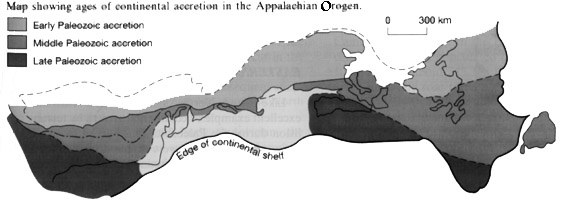of the Appalachian Orogen
during the Proterozoic
and early Paleozoic.

I. Precambrian Grenvillian Deformation and Accretion
A. Formation of Subsurface Sediments 1. proto-proto-Atlantic Ocean Basin in peri-continental seas 2. sediment deposited over continental and oceanic crust B. Avalonian Polyphase 1. collision of East Africa and North America 2. Avalonian micro-continent forms C. Collision and closing of oceanic basin 1. low angle thrusting 2. massive deformation 3. consolidating rocks D. Super-continent Fragmentation 1. Laurentia and Baltica Separate 2. Rheic Ocean Opens a. multiple micro-continents in Rheic Ocean b. major island arc systems develops in Rheic Ocean E. Late-Precambrian Grenville Accretion 1. accretion of large wedge of deformed sediment 2. Avalonian cycle ends Later-Precambrian
II. Cambrian Rifting, Erosion, and Deposition
A. Early Cambrian rifting 1. moves Grenville sediment/shoreline east 2. new oceanic basin forms, proto-Atlantic, (aka, Iaepetus) a. rifting separates Avalonian microcontinent and N. Am. b. accretion of rift remnants and volcanics B. Erosion of Mountains from Grenville Orogeny 1. vast volumes of clastics 2. heavy deposition of clastics in active ocean basin in east a. post-deposition subsidence b. accompanying rifting C. Down-warps and Rifting Along Grenville Thrusts 1. displacement from rifting 2. reversed by tensional strain/high angle growth faults D. Cambrian Clastic Influx 1. sediments from paleo-highs a. Adirondacks b. Canadian Shield c. residual Grenville highs 2. deposition in shallow marine environment
III. Ordovician Deposition, Taconic Orogeny, and Thrust
A. Cambrian-Ordovician Deposition Unconformity 1. Ordovician sea transgression 2. early Ordovician classtic influx a. clastic deposits only in emergent Grenville highs 3. basin extension reactivates growth and transcurrent faults B. Taconic Orogeny 1. arcs from Iapetus and Rheic collide with N. Am. craton a. orogeny alters basin configuration b. deposition unconformity ends 2. period of maximum extension of proto-Atlantic 3. ophilolites and melanges form a. abducted parts of oceanic crust b. volcanic sediment and assemblages c. shale, limestone, feldspar C. Proto-Atlantic closes 1. new Taconic thrust sheets develop 2. sheets ramped upward along Grenvillian decollement surfaces 3. collection of Mid-Ordovician shale deposits D. Large Thrusted Foreland Region Formed in East 1. source area for future deposition 2. ramps through Cambrian/Mid-Ordovician carbonates in west 3. tectonic breccias formed 4. Taconian cycle ends Mid-Ordovician 5. Acadian cycle begins Mid-Ordovician
IV. Silurian Post-Impact Effects, Clastic Deposition, and Basin Flattening
A. Post Impact of Two Continental Masses Colliding in Taconic 1. major mountain chain formed begins large-scale erosion 2. clastics shed to east and west 3. substantial clastic deposition in restricted Appalachian Basin B. Mid/Upper-Silurian Clastic Influx Slows 1. restricted basin flattens a. salt, anhydrite, and dolomite deposits b. smooth pre-existing fault related features
V. Devonian Acadian Orogeny, Clastic Deposits, and East Central Uplift
A. Lower Deposits Precursor to Acadian Orogeny 1. flow features 2. thick salt units B. Salt Pods Develop into Topographic Highs 1. clastic influx around highs 2. Onondaga carbonate mounds a. continued flooding of basin b. carbonate mounds develop on some salt pods C. Uplift in East Central Basin as Acadian Orogeny Progresses 1. large Upper-Devonian clastic influx 2. post-deposition influx of Lower-Devonian shale 3. clastics skirt topographic highs D. Post-Acadian / Pre-Alleghenian Tectonism 1. shallow marine water deposition a. shallow water sandstones b. shaly minor tuffs c. graywacks 2. periodic clastic influx 3. Laurasia and Gondwanaland continue to �bump and grind�
VI. Mississippian, Pennsylvanian, and Triassic Action
A. Intermittent Movement Continues from Acadian Orogeny B. Alleghenian Orogeny - Craton Directed Thrusting Dominates 1. old thrusts refolded 2. new thrusts generated a. over-thrusting b. ductile deformation D. End Pennsylvanian Deformation and Accretion Complete E. Erosion Becomes Primary Force
|
Fig. 1: Plate tectonic history of the Appalachian Orogen during the Proterozoic and early Paleozoic. |

|
| Fig. 2 |
 |
| Fig. 3: Generalized tectonic cross-section of the southern Appalachian Mountains. |
 |